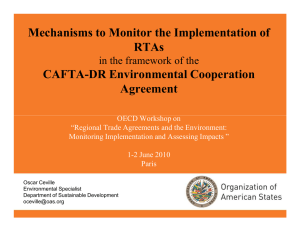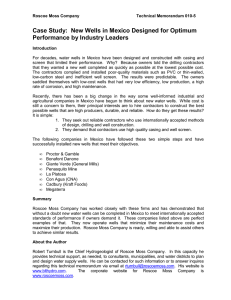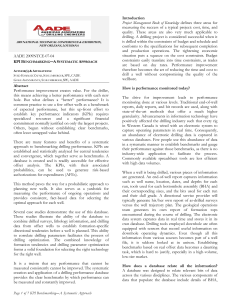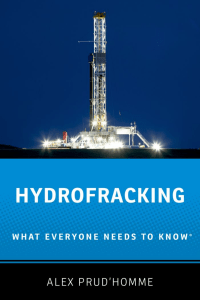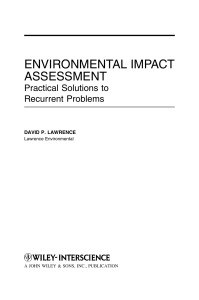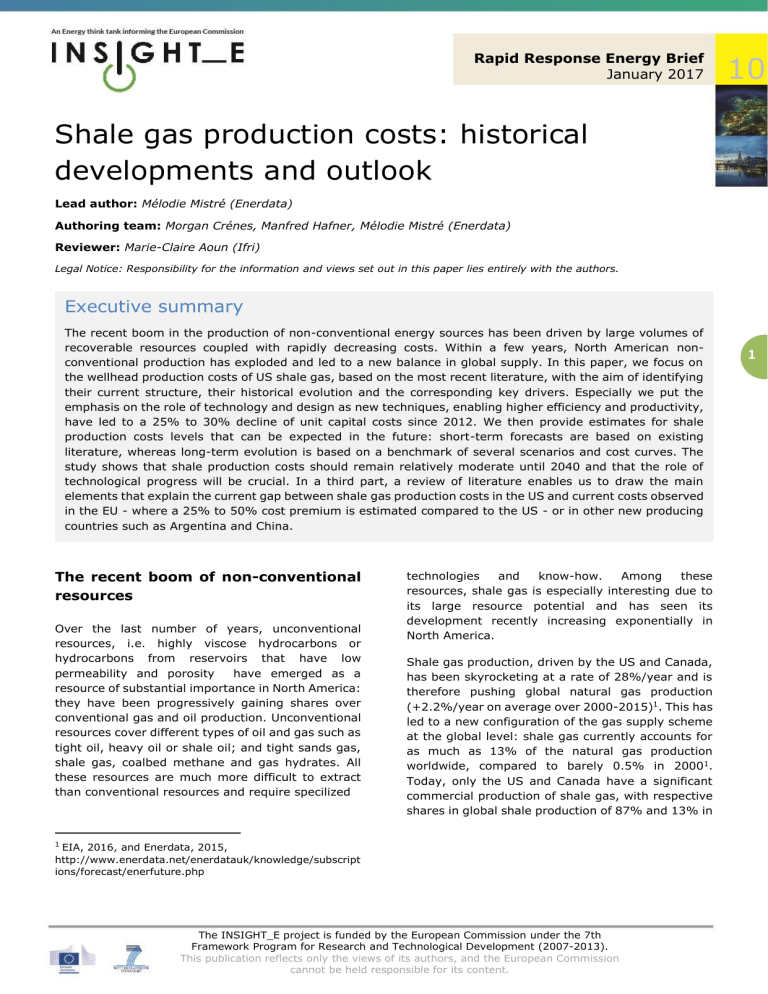
Rapid Response Energy Brief January 2017 10 Shale gas production costs: historical developments and outlook Lead author: Mélodie Mistré (Enerdata) Authoring team: Morgan Crénes, Manfred Hafner, Mélodie Mistré (Enerdata) Reviewer: Marie-Claire Aoun (Ifri) Legal Notice: Responsibility for the information and views set out in this paper lies entirely with the authors. Executive summary The recent boom in the production of non-conventional energy sources has been driven by large volumes of recoverable resources coupled with rapidly decreasing costs. Within a few years, North American nonconventional production has exploded and led to a new balance in global supply. In this paper, we focus on the wellhead production costs of US shale gas, based on the most recent literature, with the aim of identifying their current structure, their historical evolution and the corresponding key drivers. Especially we put the emphasis on the role of technology and design as new techniques, enabling higher efficiency and productivity, have led to a 25% to 30% decline of unit capital costs since 2012. We then provide estimates for shale production costs levels that can be expected in the future: short-term forecasts are based on existing literature, whereas long-term evolution is based on a benchmark of several scenarios and cost curves. The study shows that shale production costs should remain relatively moderate until 2040 and that the role of technological progress will be crucial. In a third part, a review of literature enables us to draw the main elements that explain the current gap between shale gas production costs in the US and current costs observed in the EU - where a 25% to 50% cost premium is estimated compared to the US - or in other new producing countries such as Argentina and China. The recent boom of non-conventional resources Over the last number of years, unconventional resources, i.e. highly viscose hydrocarbons or hydrocarbons from reservoirs that have low permeability and porosity have emerged as a resource of substantial importance in North America: they have been progressively gaining shares over conventional gas and oil production. Unconventional resources cover different types of oil and gas such as tight oil, heavy oil or shale oil; and tight sands gas, shale gas, coalbed methane and gas hydrates. All these resources are much more difficult to extract than conventional resources and require specilized technologies and know-how. Among these resources, shale gas is especially interesting due to its large resource potential and has seen its development recently increasing exponentially in North America. Shale gas production, driven by the US and Canada, has been skyrocketing at a rate of 28%/year and is therefore pushing global natural gas production (+2.2%/year on average over 2000-2015)1. This has led to a new configuration of the gas supply scheme at the global level: shale gas currently accounts for as much as 13% of the natural gas production worldwide, compared to barely 0.5% in 20001. Today, only the US and Canada have a significant commercial production of shale gas, with respective shares in global shale production of 87% and 13% in 1 EIA, 2016, and Enerdata, 2015, http://www.enerdata.net/enerdatauk/knowledge/subscript ions/forecast/enerfuture.php The INSIGHT_E project is funded by the European Commission under the 7th Framework Program for Research and Technological Development (2007-2013). This publication reflects only the views of its authors, and the European Commission cannot be held responsible for its content. 1 Rapid Response Energy Brief January 2017 2015; China and Argentina have recently started to develop their shale resources, which are estimated to be among the biggest in the world. Other countries with large shale gas resources include Algeria, Mexico, Australia and South Africa, as well as the European Union. decrease costs (for example through pad drilling which allows to drill multiple wells without moving the rig) or by contributing to improve the performance and production of the well (for example through the use of longer laterals), leading therefore to lowering the unit cost of the well. The commercial development of shale gas, which started to take off in the US around 2005-2007 and since 2008 in Canada, took off with the combined application of horizontal drilling and multi-stage hydraulic fracturing. In the US, the number of horizontal wells has increased from about 9% of total wells drilled in the early 1990s to more than 50 % in 20102. These technical innovations and improvements unlocked the potential for production of gas from tighter shale formations. The expansion of shale gas production has been accompanied by falling unit production costs, making it possible for shale gas to become rapidly competitive. Last but not least, external factors linked to the political or economic context can strongly impact the economic viability or feasibility of a play. Public acceptability of unconventional oil and gas production also represents a major issue to take into account. Federal and local regulations are not always favorable to hydraulic fracking, and may lead as a result to a complete ban of the technique, as it was decided in some European States such as France, Germany or Bulgaria. Environmental and health concerns are growing and can raise significantly the costs of shale gas projects. On the contrary, a favourable business environment such as the existence of a Main drivers of the economics of shale plays Many factors can affect the economics of unconventional gas or oil plays. Production costs depend of course on geological parameters of the considered plays, their geographical location and size, the depth of the reservoir. Drilling in a remote area to reach a reservoir in hard rock formations will have a higher cost than easily accessible resources. Intrinsic features of the targeted reservoir, its size, porosity or permeability but also the quality of the liquids trapped, have a direct impact on the economics of the well. These characteristics will determine which technologies and methods will be required to extract gas, and their level of complexity of the process. The liquids content of the targeted shale gas, which can widely vary according to the considered play, is also essential for estimating the economic potential of the play. Additional geographical parameters, such as the existence of aboundant water resources near the play, are also essential for shale gas extraction. Technological parameters themselves play a significant role by either enabling to directly a gas industry and production in the country, contributes to the economics of shale gas production, as infrastructure is already there. The presence of contractors and suppliers with a strong know-how and competitive services can help reduce production costs. A facilitated access to financing for the industry players is also important for the development of unconventional projects. Given these various situations, a key question is therefore to understand how production costs of shale gas plays have evolved and how they could further develop -both in North America or in potential other producing countries- as this can help assess the future of shale gas in the global energy system. Evolution of historical shale gas production costs in North America: growing resources and decreasing costs Shale gas resources in North America The development of shale gas resources has grown quickly over the last decade in North America and has enabled decreasing production from conventional gas. In the US, the shale gas production reached 381 billion cubic meters (bcm) in 20153, 2 EIA, 2010, Quantifying Drilling Efficiency, https://www.eia.gov/workingpapers/pdf/drilling_efficiency .pdf 3 EIA, 2015, http://www.eia.gov/dnav/ng/ng_prod_shalegas_s1_a.htm 10 2 Rapid Response Energy Brief January 2017 accounting for nearly 45 % of the domestic natural gas production, compared to less than 10 % in 2007. In Canada, the volume of shale gas produced has tripled over 2010-2015 and reached about 40 bcm4. This growing expansion of shale gas has led to a strong increase in North American reserves of natural gas, which have been regularly reevaluated over the last years: in 2015, the EIA re-estimated US Technically Recoverable Resources (TRR) at 17.4 trillion cubic meters (tcm), vs 15.5 tcm in 20135. With growing expected recoverable resources, the shale gas industry has become more attractive for investors. Overview of the production costs structure for shale gas wells Thanks to technological progress, production costs of shale gas sources have reduced over the last years. The term of “production costs” used in this paper refers to wellhead costs including capital costs (CAPEX) and lease operating expenses (LOE). Land acquisition costs, operating processing and transport costs, taxes and royalties, interest rates are excluded. The following figures are based on the latest report of the EIA, which takes into account 5 major shale gas plays in the US, i.e. Bakken, Eagle Ford, Marcellus, and the Delaware and Midland plays in the Permian basin: Figure 1- Major shale gas plays in the US6 For all considered plays, more than 65% of the production costs consist of capital costs (CAPEX) (see Figure 2), which themselves mainly include drilling and completion costs (nearly 95% of CAPEX). The average capital costs per well in these five onshore American plays ranged in 2014 from $5.9 million to $8.2 million per well. As a comparison, drilling and completion costs at the Duvernay play in Alberta, which accounts for nearly 20% of the estimated Technically Recoverable Resources in Canada, were estimated to range between $8.1 million and $13.5 million per well in 2014. The cost structure presented in Figure 2 reflects the weight of the different cost components as of 2014, based on the average of the above-mentioned plays weighted by the Expected Ultimate Recovery (EUR) estimated by the EIA. Figure 2- Average current structure of wellhead production costs for shale gas, 20147 6 4 EIA, 2016, http://www.eia.gov/todayinenergy/detail.php?id=27512 5 EIA, 2015, Technically Recoverable Shale Oil and Shale Gas Resources including updates, https://www.eia.gov/analysis/studies/worldshalegas/ 10 7 EIA, 2016, http://www.eia.gov/petroleum/drilling/ EIA, 2016,Trends in U.S. Oil and Natural Gas Upstream Costs,https://www.eia.gov/analysis/studies/drilling/pdf/up stream.pdf 3 Rapid Response Energy Brief January 2017 The cost breakdown of shale gas is different from conventional gas, as production moved from vertical wells to horizontal or multidirectional shale wells. Especially, drilling costs for conventional gas wells account for much more of the total well CAPEX. Drilling costs (for horizontal drilling) represent $2.1 million to $2.6 million per well in average, accounting for roughly 30% to 40% of the total capital costs (according to plays). These costs include mainly expenditures from rig rental, drilling fluids, casing, liner and cement. Before the expansion of horizontal drilling within unconventional plays, drilling costs ranged from 60% up to 80% of the capital costs. Completion costs amount on average to $3.8 million to $5.6 million per well, usually representing 60% to 70% of the capital costs. They include wellhead equipment for fracking, completion costs of liner and tubing, proppant and other costs (water and pumping). Over the last years, they have been sharply increasing as the techniques used are becoming more complex due to the use of larger laterals in horizontal drilling. Facility construction costs have a minor contribution to the capital costs as they usually amount for less than half a million dollars. They include equipment to push product to gathering lines such as separators, flow lines, roads, pumps or compressors. Additionally to CAPEX, the operating costs (OPEX) considered in wellhead production costs include lease operating expenses (LOE), such as water treatment and disposal expenses, the fuel costs to operate wellhead equipment and pumps, the maintenance of equipment and general and administrative expenses (mainly labor). These costs are highly variable and are specific to each play and sub-play (See Figure 4). As a comparison, LOE account for about 35% of total OPEX costs (i.e. including transport), the other main cost item being transport (not included in wellhead costs). The EIA estimates an average cost of $1.0 million to $3.5 million for LOE for a well with a 20-year life cycle (with a unit LOE ranging from $0.4 to $2.8 per MMBtu). Information available for the Canadian Duvernay play reports an LOE of about $1/MMBtu. Operation and maintenance costs of artificial lift equipment as well as water disposal are the two main cost items of LOE, however their contribution varies widely according to the considered well, and cost related to water treatment can account for as much as 40% of LOE in some plays (Bakken). Figure 4- Detailed structure of LOE by play (low OPEX configuration), 20149 Figure 3 provides an overview of the weight of CAPEX in the different considered plays. Figure 3- Detailed structure of well capital costs by play, 20148 Evolution of shale gas wellhead production costs over the last decade When looking at the evolution of historical drilling and completion costs in major US shale gas plays (Figure 5), it appears that they follow a comparable trend in the considered fields. Drilling and completion costs first rose sharply between 2006 and 2012: between 40 and 50%, and then dropped at an 8 EIA, 2016,Trends in U.S. Oil and Natural Gas Upstream Costs,https://www.eia.gov/analysis/studies/drilling/pdf/up stream.pdf 10 9 EIA, 2016,Trends in U.S. Oil and Natural Gas Upstream Costs, https://www.eia.gov/analysis/studies/drilling/pdf/upstrea m.pdf Due to the high variability of OPEX among subplays for a given play, the study provides distinct data for low OPEX and high OPEX sub-plays for every of the five plays. 4 Rapid Response Energy Brief January 2017 average rate of 10 to 15% per year to amount to around $6 million per well on average in 2015. Figure 5- Average well drilling and completion costs indexed to 2014 well design, dollars per well10 10 Main cost reduction drivers Technical improvements have been a key enabler for costs reduction. Multi-pad drilling, which represented 5% of the total number of wells drilled in 2006 among the nine biggest US shale plays, expanded quickly and accounted for about 60% of the wells drilled in 2013. This technique allows considerable economies-of-scale as several wells share the same facilities and cost scan be spread across the wells. Figure 7- Traditional vertical single well pad compared to directional and multi-pad drilling11 5 The main reason for the past drilling and completion cost increase was the growing complexity of wells built: over 2006-2012, the average vertical and lateral length of North American wells rose by 50%, to reach about 15 000 feet (some plays today spread to 10 000 feet laterally). The total amount of proppants and other completion fluids used, with the intensification of the number of fracking stages, rose sharply (more than 10-fold over the period) thus increasing the associated completion costs. However major gains in wells productivity and efficiency, combined with new extraction technologies, have enabled a huge increase in well performance over the last years, leading to the decline of unit capital costs since 2012 (Figure 6). Figure 6- Evolution of unit drilling and completion costs over 2010-2014 in major US shale gas plays9 Some operators using multi-pad drilling cut their costs up to 30% in 2014 and up to 20% in 2015. Although total proppants costs per well have grown, the concentration of proppant and fluids used for fracking is growing which makes efficiency increased quicker than the costs. New proppant mixes, using water with gel, enable a better performance, and lower unit costs per well. Besides these technical improvements, the access to an appropriate service industry is essential: the multiplication of qualified service providers has contributed to lower total and unit production costs. For example, the growing rig costs have come down due to the increasing pressure of competition which led the way to a current context of rig surplus. Today, about 7 000 US companies are active in onshore gas production, including some 2 000 drilling operators. The US shale gas industry also benefits from a supportive capital market, granting an easy access to equity and debt finance for shale operators, that are traditionally smaller than players in the 10 EIA, 2016,Trends in U.S. Oil and Natural Gas Upstream Costs,https://www.eia.gov/analysis/studies/drilling/pdf/up stream.pdf 11 Greater Houston Partnership, http://www.constructioncitizen.com/blog/2014-newnormal-houston/1403121 Rapid Response Energy Brief January 2017 conventional resources industry. This is all the most important as the shale industry has a different cycle than conventional activities: as resources are more scattered and difficult to produce than conventional resources, a continuous investment in drilling wells is necessary, which requires constant investment. The recent decrease in both capital costs and operating expenses has led to relative low unit production costs for shale gas in the US, which, according to the EIA, reached $3.2/MMBtu to $3.6/MMBtu on average in 2014 (range with low and high OPEX). However, production costs can vary a lot among plays: Marcellus is one of the cheapest play with a wellhead production cost in some subfields currently under $2.0/MMBtu, compared to costs as high as 9.7$/MMBtu in some Permian Midland sub-plays. According to the EIA, costs further dropped in 2015, with an average decrease of 20% for drilling and completion costs. Cost variation in OPEX has become lower: lease operating expenses were down by about 5%, as the lower activity puts pressure on services rates (for maintenance of artificial lift equipment for example); energy savings have enabled some cost reduction too. As a result, production costs in 2015 decreased to a level of $2.8/MMBtu to $3.6/MMBtu for the five above-mentioned plays. Shale gas production in the US was driven in 20072008 by high gas prices on the market (Figure 8). In 2008-2009, the economic crisis combined with a strongly increasing shale gas development lead to a collapse of the US gas prices; these prices strongly disconnected from other major international gas prices as the US could not export its huge oversupply. In order to maintain their profit, US shale producers turned to tight oil by applying the shale extraction techniques to tight oil plays; in fact, at that time, oil prices were still high. Substantial volumes of shale gas associated to tight oil exploration thus contributed to the continuous increase of shale gas production. Meanwhile, technological improvement and efficiency have enabled to keep shale production costs decreasing since 2012. With the oil price collapse since mid2014, shale producers have made considerable efforts to run more efficient operations; despite the fall of drilling activities over the last few years, the 12 EIA and Canadian National Energy Board (NEB), https://www.eia.gov/dnav/ng/ng_pri_fut_s1_m.htm http://www.eia.gov/dnav/ng/ng_prod_shalegas_s1_a.htm higher wells efficiency and performance enabled to push shale gas production up. 10 have Figure 8- Evolution of yearly North American shale gas production compared to monthly Henry Hub prices12 Future development of costs in North America Short term evolution of shale production costs As mentioned above, technical improvements but also business environment have affected and could affect further the production costs of shale gas in the short-term, especially the CAPEX part. According to the EIA (Figure 9), drilling and completion costs of the major US shale gas plays are expected to follow a slightly upward trend from 2016 (between +1% and +5%/year until 2018), following the significant drop in costs in 201513. The main underlying assumption here is that significant drilling efficiencies have already been achieved, and that further improvement will be more progressive. However, past estimates show that the increase in drilling efficiency has been underestimated. It should thus not be excluded that significant potential savings could be achieved through the further development of more efficient drill pads design, as drilling more and tighter spaced wells on a single pad can lower well sharing costs, which represent between 10% and 20% of well drilling and completion costs. The EIA estimates that in some sub-plays, building up to 16 or 24 wells per pad could enable to reduce sharing costs by 70% to 90%, i.e. representing about $0.7-$0.9 million of potential savings from economies-of-scale. 13 EIA, 2016,Trends in U.S. Oil and Natural Gas Upstream Costs,https://www.eia.gov/analysis/studies/drilling/pdf/up stream.pdf 6 Rapid Response Energy Brief January 2017 Figure 9- Drilling and completion costs variation compared to previous year in major US shale gas plays13 A comparison by play of the evolution of forecasted drilling and completion costs with two scenarios (the evolution of costs assuming the same well design as in 2012, and the evolution of well design assuming that these costs remain unchanged over 20122018), shows that the cost increase is driven by the growing complexity of wells design (Figure 10). unknown or considered as non-profitable a decade ago. Available resources have been extended, and the cost of producing many of the remaining resources has progressively reduced. As a result, the marginal cost curve of shale -gas as well as oiltends to be lower and flatter than the one for conventional resources, which impacts in turn the total curve (conventional and non-conventional). The effects of unconventional sources on resources base (which becomes larger) and on production costs (which follow a decreasing trend) have been continuously underestimated. As an example, Figure 11 shows how the growing US production from shale oil resources at affordable costs has impacted the global oil curve, which has become progressively flatter: Figure 11- Impact of the US shale oil production on the global oil cost curve15 Figure 10- Drilling and completion costs variation in Bakken compared to previous year in scenarios assuming constant well design or expenses base 201214 Long-term evolution production costs of shale gas On the long-term, there is a considerable uncertainty about the amount of technically recoverable shale gas resources. First because the estimated ultimate recovery per well (EUR), which is the expected cumulative production over the life of a well, varies widely among shale gas wells -the production of a sweet spot will be the highest and cheapest. And secondly as mentioned above, technological improvements have shown that it was possible to recover gas from resources that were 14 EIA, 2016,Trends in U.S. Oil and Natural Gas Upstream Costs,https://www.eia.gov/analysis/studies/drilling/pdf/up stream.pdf 10 A central question to estimate the future shale gas production costs is therefore to determine the shape of cost curves in 2030 or 2040 (i.e. how high the forecasted cumulated production of shale gas will be at those horizons), in order to estimate future production cost levels. In order to test the long-term sensitivity of shale gas wellhead production costs to the shale gas production evolution, several scenarios with different shale gas production patterns are set. Three scenarios are based on Enerdata’s forecasts: the first scenario, “Ener-Blue”, is based on the central assumption that emissions targets defined in the Intended Nationally Determined Contributions (INDCs) at the COP21 are successfully achieved; clean energy sources are favored for their low carbon content, and production from 15 Goldman Sachs Investments Research, http://www.edisonthoughts.com/2015/05/whatsmarginal-cost-of-oil-supply-60bbl.html 7 Rapid Response Energy Brief January 2017 unconventional gas is moderate. “Ener-Green” defines an ambitious scenario compatible with a limitation of the global temperature increase at around 1.5-2°C, and includes stringent energy and climate policies: there is a phase out of fossil fuel subsidies, and a strong expansion of renewable energies; the expansion of unconventional resources remains limited. The third scenario, “Ener-Brown”, describes a world with durably low fossil fuel energy prices, with a strong development of unconventional oil and gas resources. The last scenario used is the Reference case of the EIA 16, which shows a significant development of unconventional resources, however more moderate than in “Ener-Brown”. For each scenario, a cost simulation is conducted, based on two recent shale gas cost curve shapes published by Rystad Energy17 and the UC Davis Institute of Transportation Studies18. The Rystad Energy cost curve includes data from over 10 000 US individual fields. The UC Davis ITS cost curve is based on average type well from plays in the US, Canada and Mexico, which explains that the identified costs are higher than those of the Rystad cost curve. Figure 12 presents the forecasted cumulated shale gas production at horizon 2030 and 2040 and the corresponding production costs (CAPEX and LOE) derived from the two exogenous cost curves. 16 2015-North-American-Natural-Gas-Resources-and-Supplyfor-CA-ITS-Davis.Baker-Inst-18Feb2015.pdf 19 Enerdata based on EnerFuture scenarios, http://www.enerdata.net/enerdatauk/knowledge/subscript ions/forecast/enerfuture.php, and EIA Reference case (AEO2016) based on above mentioned cost curve sources, which both take into account associated gas. EIA, Annual Energy Outlook (AEO) 2016, http://www.eia.gov/forecasts/aeo/ 17 Rystad Energy,2015, http://www.rystadenergy.com/NewsEvents/PressReleases /us-gas-prices-must-reflect-the-cost-of-production18 UC Davis Institute of Transportation Studies, 2015, North American resources and natural gas supply to the State of California, http://steps.ucdavis.edu/files/02-19- 10 The results show a comparable trend in all scenarios and with both cost curves used: on the long-term, shale gas production costs in the US will remain moderate: between 2.1$/MMBtu and 4.2$/MMBtu at horizon 2030, and between 2.5$/MMBtu and 6.0$/MMBtu at horizon 2040, whether the scenarios considered are optimistic regarding the development of shale gas production (“Ener-Brown scenario”: about 860 bcm produced in 2030 and 1015 bcm in 2040) or moderate (“Ener-Blue” scenario: 565 bcm in 2040 and AEO reference case: 821 bcm in 2040). Figure 12- Forecasts of cumulated shale gas production and production costs according to different scenarios from Enerdata and EIA19 8 Rapid Response Energy Brief January 2017 This level of forecasted production costs is relatively low compared to the current average costs identified by the EIA which lay between 2.8$/MMBtu and 3.6$/MMBtu (see previous parts of the paper). In addition to scope effects (number of wells included in the study, weighted average…) and a high short-term uncertainty (drilling and completion costs have been further lowered by 20-25% from 2014 to 2015 according to the EIA), this outcome is mainly due to the fact that the EIA does not consider associated gas from tight oil plays for its study of historical costs. Along with the growing exploitation of tight oil plays, significant quantities of associated gas are produced as “by-product” with tight oil, for a cost approaching $1/MMBtu to $2/MMbtu according to the used costs curves. This phenomenon is relatively new but has been developing since 2010. In 2013, associated gas from tight oil plays represented about 45 bcm in the US20, i.e. more than the coalbed methane production. The future development of this “cheap” associated gas could be substantial as tight oil production is forecasted to skyrocket by nearly 55% to reach 7.1 million of barrels per day in 2040 in the AEO 2016 Reference case. This could lead to reassess the volume of associated gas available at a very low marginal cost. Thus, despite a growing production of shale gas and associated gas from tight oil plays, production costs on the long-term may prove to be even lower than they currently are. Given the relative flat cost curves associated to shale gas and the forecasted shale oil and gas production levels, we can conclude that geological parameters will not be the key driver of the production costs evolution in the long-term. Key enabler will be technological progress, which should determine which shale gas volumes will be recoverable in the future and at which cost. 20 Baker Hughes, EIA and Labyrinth Consulting Services, http://www.resilience.org/stories/2015-0310/exxonmobil-ceo-wrong-about-resilience-of-tight-oilproduction/ 21 ICF for the EC, 2014, Macroeconomic impacts of shale gas extraction in the EU, http://bookshop.europa.eu/en/macroeconomic-impactsof-shale-gas-extraction-in-the-eupbKH0214481/downloads/KH-02-14-481-ENN/KH0214481ENN_002.pdf;pgid=GSPefJMEtXBSR0dT6jbG akZD00002_LZJA6G;sid=TdkgGd2VDRwgOYWkBkq-vrwALo- 10 Shale gas production costs outside North America Can the EU learn from the North American experience? The “shale revolution” in North America has shown that shale gas resources could be exploited at an affordable cost. This section assesses the main elements that could drive up or down the production costs of shale gas in other regions of the world compared to the North American costs, especially in the European Union, if countries with shale resources were to develop them. Estimated non-conventional gas resources in Europe are substantial. According to a 2014 ICF study, Ultimately Recovery Resources (URR) in the EU-27 amount to 12.3 tcm21; EIA 2013 estimates that European Technically Recoverable Resources within the EU range around 13.3 tcm, compared to 16.2 tcm in Canada and 17.4 tcm in the US (as of 2015)22. However, several studies show that shale gas production costs within the European Union may be much higher than the costs in North America. Basically, the first parameter to take into account when assessing the shale gas potential is the size of available resources. Poland, with 30% of the estimated European Technically Recoverable 22 Resources (4.1 tcm) , has been seen as a promising place for shale gas development. However in 2012, the Polish Geological Institute reported much lower estimates for recoverable shale gas resources in the range of 346 to 768 bcm23, impacting heavily the forecasts of future production volumes and costs. The lesson here is that there is a high uncertainty of recoverable resources estimates, especially in countries where there is still no commercial development of shale gas resources, i.e. a lack of robust production data. a5D2U6s=?FileName=KH0214481ENN_002.pdf&SKU=KH0 214481ENN_PDF&CatalogueNumber=KH-02-14-481-ENN. 22 EIA, 2013, https://www.eia.gov/analysis/studies/worldshalegas/ 23 Polish Geological Institute, 2012, https://www.pgi.gov.pl/docman-dokumenty-pigpib/docman/aktualnosci-2012/zasoby-gazu/769-raporten/file.html 9 Rapid Response Energy Brief January 2017 It remains highly uncertain how much gas would be recoverable with today's technologies, and even more difficult to forecast how much could be profitable to extract. The question of the replicability of North American shale gas plays is also based on the strong assumption that geological conditions in other parts of the world are relatively similar to the North American conditions. Once again in Poland, rocks were found to be much harder to fracture than in US plays due to higher clay content; most of the reservoirs are also much deeper (3 to 5 km deep, vs only 1 to 2 km in many US plays). Besides specific geological conditions that can differ among countries in Europe and in North America, capital and operating costs are not expected to be comparable to US costs. In its 2014 analysis, ICF assumes capital costs for EU shale wells to be 50% higher than for US wells, based on the cost difference observed between CAPEX in Polish pilot programs ($10 to $15 million reported at that time) and US similar wells. As a comparison, production costs of exploration wells in the UK are estimated to amount to about $17 million per well24. Several factors can explain this capital cost premium. First, commercial shale production has not taken off in Europe, and current projects are in an experimental phase, making design efficiency currently difficult. In the UK for example, the shale industry is still in an early stage: only five wells have been drilled, and one fractured and tested. Drilled wells are rather single wells as opposed to multi-pad technique. Secondly, the mobilization of drilling and completion equipment and services for a limited number of wells in scattered locations tend to increase the corresponding costs compared to the US, where there is good access to resources on flat, large-scale plays, whereas Europe has a high population density and many protected natural areas which limits the accessibility of resources. Regarding operating costs, ICF estimates a 25% cost premium for EU wells compared to the US, based on the assumption that equipment and maintenance goods or services (i.e. 40-50% of LOE in average as described in Figure 2 of this paper) are twice higher in Europe. This is mainly due to the 24 Morgan Stanley, 2014, Global Insight: Is the US shale revolution replicable? 25 JRC, 2012, Unconventional gas: Potential Energy Market Impacts in the European Union, 10 lack of operators and services providers among European countries, compared to the large-scale drilling and completion industry in the US. Labor costs, which represents about 25% of LOE costs in average in the US but can account for as much as 50% in some plays, are assumed to be similar in Europe and in the US. Assuming a similar costs structure to that in the US as of 2014, expected production costs in Poland would be 45% higher than US costs at the same period. This results in production costs ranging between $13 million and $21 million per well. Similar conclusions were drawn in a 2012 study of the JRC, which estimates that shale gas production costs in Europe range around $5 to $20 million25. Similarly to what’s happening in North America, both studies note that there is nevertheless a cost reduction potential in drilling and completion thanks to a “learning-by-doing” effect as well as economies of scale. However, it supposes mature and largescale shale gas activities. Moreover, socioeconomic and environmental factors are critical when assessing the potential production costs of shale gas. The current situation in Europe, where populations may not be in favour of shale gas exploration, and where environmental regulatory constraints have become stricter can be a high barrier to shale gas development. The higher density of the EU population compared to the US, but also sharper concerns of citizens and governments about health and environmental issues (water and air pollution, sustainability of resources and emissions), make the development of shale industry difficult. Unclear and various regulations among the different European countries have also contributed to slow down investments in the shale gas business. Overview of today’s and future possible development of shale gas around the world… at which costs? Today, six countries represent nearly 60% of the worldwide estimated technically recoverable resources (TRR): China has the biggest shale gas resources with 31.6 tcm, followed by Argentina (22.7 tcm) and Algeria (20 tcm). US, Canada and https://ec.europa.eu/jrc/en/publication/eur-scientific-andtechnical-research-reports/unconventional-gas-europepotential-energy-market-impacts 10 Rapid Response Energy Brief January 2017 Mexico’s resources amount together to 50.5 tcm. Outside North America, commercial development of shale gas has nevertheless been reached only in two countries: China and Argentina. an improved know-how that the country developed through many joint-ventures with American companies both in the US and in China (Halliburton, FTS International…). Over the last years, Argentina has developed shale gas exploration and production in the large Vaca Muerta play, which is a historical play for oil production and which represents today 40% of the country’s shale gas resources. In the Loma Campana field, about 400 wells have been drilled most of them being vertical- and have benefited from the US expertise and technologies, which enables to keep drilling and completion costs relatively moderate. Between 2011 and 2014, drilling and completion costs are reported to have been reduced by 36%, reaching about $7 million per well by the end of 201426. This reduction rate is similar to the cost reduction observed in the US. The current development of horizontal drilling could, if successful, make it possible to further reduce capital costs, however these costs remain significant in 2015 compared to the US: $28 million estimated for an assumed 1.5 km lateral length well, compared to $5 to $7 million for a similar well in the US (such as Eagle Ford). Proppant costs, which account for up to 53% of the completion costs27, are expected to be lower as the state operator of the plays, YPF, has acquired several sand mines to avoid costly sand imports. Operating expenses benefit from low water expenses due to the absence of constraints in water supply. Furthermore, the supportive regulatory context in China appears as a key enabler of shale gas development, which is supported by strong subsidies (however announced to decrease in 2016). By combining large resources, substantial investments, improved know-how and continuous regulatory incentives, China could thus strongly reduce its non-conventional gas production costs in the future. China, in its 13th five-year Plan published in 2016, has set an ambitious target of producing 30 bcm of shale gas by 2020. The country started shale gas development in 2011, and has drilled more than 700 wells by 2015. On average, drilling and completion costs in the shale plays of the Sichuan basin range between $10.4 and $11.7 million per well in mid201522. This is a 23% decrease compared to costs levels of 2013. In the first commercial large-scale field of Fuling, the main operators, Sinopec and Petrochina, reported a substantial reduction of their drilling costs by respectively 9% and 30% in 2014. A further reduction towards $8.1 to $9.7 million per well, i.e. up to 40%, is targeted by Sinopec by 201726. These cost reductions have been driven by 26 Morgan Stanley, 2014, Global Insight: Is the US shale revolution replicable? 27 Macquarie Research, 2015, Argentina Shale, http://andesenergiaplc.com.ar/wpcontent/uploads/2012/08/MacquarieResearchArgentinaShale.pdf Conclusion > The exploitation of non-conventional resources, which started in the US, is still very recent. Today, there is therefore a high uncertainty about the recoverable resources and the potential evolution of associated production costs. An even greater uncertainty surrounds the potential of non-conventional commercial production volumes outside of North America. > In the US, shale gas production boomed surprisingly quickly, and the regular reestimation of more optimistic forecasts shows that shale expansion has been much faster and stronger than expected. Thanks to its huge and sustained shale gas production, the US which until recently was expected to become a major LNG importer- is now about to become a major LNG exporter28. > Our paper underlines that over the last few years, the unit production costs of US shale gas have decreased significantly (-25% to 30% over 2012-2015), mainly due to considerable technological improvements, as well as to the development of a mature and large equipment and maintenance service industry. On the long-term, a large low cost shale resource base draws a relative flat shale 28 EIA Reference case, Annual Energy Outlook 2010 and Annual Energy Outlook 2016, http://www.eia.gov/outlooks/aeo/pdf/0383(2016).pdf 10 11 Rapid Response Energy Brief January 2017 10 gas cost curve. As a result, shale production costs will remain relatively moderate (estimates vary from 2.5$/MMBtu to 6.0$/MMBtu in 2040 according to the considered scenarios). The production of gas associated to the production of oil in tight oil formations, plays a growing role in producing “cheap” shale gas. > In the EU, despite a high shale resource potential (e.g. France, Poland), production costs are much higher due to geological factors, but also to external factors: an often unfavorable social and regulatory context, strong environmental concerns, and the absence of a mature oil and gas drilling industry. CAPEX and OPEX which would arise from EU shale gas wells are estimated to be respectively 50% and 25% higher than for US wells. > In other parts of the world, a huge shale potential exists (China, Algeria, Argentina, Mexico…). The current state sponsored development of shale gas in China indicates that a future exploitation of shale gas resources at affordable and decreasing costs might be possible. For further reading or information, please visit www.insightenergy.org 12

